Irrigation boosts farming in Bukwo

Farmers harvest onions in Chebombai Village, Amanang Sub-county, Bukwo District at the weekend. An irrigation project has doubled crop yields in the area. PHOTO | OLIVIER MUKAAYA
What you need to know:
- Mr Franklin Kitiyo, the district production officer, said the irrigation technology has empowered farmers to grow crops on a large scale, enabling them to fight household poverty.
The Sprinkler Irrigation Project has spurred agricultural production in Bukwo, with crop yields doubling, according to district officials and farmers.
Mr Franklin Kitiyo, the district production officer, said the irrigation technology has empowered farmers to grow crops on a large scale, enabling them to fight household poverty.
“The locals have embraced irrigation to solve the problem of erratic rains and also fight food insecurity,” he said on Saturday.
Mr Geoffrey Arapsali, the chairperson of farmers in Bukwo, said the irrigation scheme, which was constructed in 2019, has boosted crop productivity.
“The technology has brought life to the farmers and we ask the government to roll it out to the neighbouring districts,” Mr Arapsali said.
Ms Annet Cheptoek, one of the farmers, said she is able to support her children’s education because her yields doubled.
“We could rarely grow anything here after the first season and this had become worse due to climate change effects, but irrigation is supporting us,” she said.
Ms Cheptoek, a member of a farming group dealing in onion growing among other crops, thanked the government for implementing the irrigation scheme.
“Before I would harvest about eight bags of Irish potatoes in an acre, but now, I can harvest about 50 bags,” she said.
Ms Jackline Kitiyo, another farmer, said since the scheme started, farmers have ventured in growing different crops. “Our crops have yielded well, but we have a problem accessing markets,” she said.
Challenges
Mr Kitiyo said despite the increased production, the farmers face a challenge of lack of market for their produce and the poor road network.
“Sebei is a food basket, but it faces a problem of poor feeder roads. The farmers incur huge costs to transport their produce from rural areas,” he said.
Mr Patrick Mutai, another farmer, said the government should allocate enough funds to the local governments to work on roads.
“When it rains, most roads in rural areas are cut off. Our produce is rotting in gardens because we cannot transport them,” he said.
The farmers also demand for a seed multiplication centre and storage facilities for irish potatoes.
Mr Rogers Masaaba, the assistant manager for water for production in eastern region, said more than 41 irrigation schemes have been constructed in the region. “The schemes have supported farmers to grow different crops despite the effects of climate change,” he said.
Sebei Sub-region has a population of about 300,000 people and the poverty rate stands at about 24 percent.
Irrigation plant
The Sprinkler Irrigation Project that was constructed by the Ministry of Water at Chebombai Village sits in Amanang Sub-county on an 8.3 acres of land. The facility also supports four fishponds.
The project is part of the directive of President Museveni to implement small scale irrigations near watersheds to improve the livelihoods of locals.
The beneficiary farmers, including persons living with HIV/Aids, widows and widowers, grow crops such as onions, tomatoes, Irish potatoes, cabbages, green paper and watermelon.





